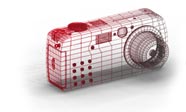 |
|
||
|
|
|
Main / Articles: Outside shotsIt's happened again. You come back from a glorious hiking trip to Mount Rainier, where you filled frame after frame with images of bright wildflowers, emerald meadows and summits sparkling against an ultramarine sky. But when you get your pictures back, instead of dazzling, the wildflowers are dull, the meadow looks as drab as your front lawn in August, and that sparkling summit is a big white blob. You're not asking to be the next Ansel Adams, you just want a few good photos that accurately reflect the brilliance of the landscape and the wonder you felt in its presence. What can you do? First, if you don't already have a firm grasp of the basics -- composition and exposure -- then get it. Teach yourself or take a class. You'll find dozens of books at your local library; and photography schools, outdoor clubs and community colleges offer classes. But let's say you already have some basic photography skills. You've been taking photos for a while with your 35 mm SLR camera, and have a good eye for a nice shot. Yet even though you know how to work your light meter pretty well, your photos never seem quite as magnificent as they did when you shot them: The color isn't as brilliant, the vista not as breathtaking. If your compositions are strong, you're off to a good start, since a striking image can overcome many technical problems. Chances are, however, that like this budding photographer -- who's been budding but refusing to bloom for the past 15 years -- you may be a bit of technophobe and haven't pushed yourself to gain the knowledge that could make your compositions shine. In their book "Photography Outdoors," Art Wolfe and Mark Gardener, two well-known local photographers, write: "Photography can be impenetrably technical, which keeps many people from becoming better photographers. However, the more you understand about the technology, the more artistic you can be, and ultimately, the better pictures you can take." For one, study up on lenses. Find out what kind is best for the type of pictures you like to shoot. Are you most interested in landscapes, wildlife or close-ups (wildflowers, for example)? If the answer is all three, then a versatile lens like an 80 mm to 200 mm zoom lens with a macro setting might do the trick. If you most enjoy wildlife photography, bigger lenses (300 mm and up) will help you get better photos. Detailed close-ups and magnified images may require specialized equipment like extension tubes and teleconverters. Do your research so you have a good idea about what lenses you should be packing. And if you get the urge to splurge, keep in mind one of bird photographer Arthur Morris' favorite sayings: "You can buy the lens but you can't buy the eye." You should also educate yourself about the variety of gadgets that can help transform a colorless, vague photo into a bright and detailed one. These include filters, tripods, flash, diffusers and reflectors (some of which can be improvised with things like sunglasses or a T-shirt). Have you always wondered why your photographs of Lake Washington never come out as bright blue as you want them to? The answer might be as simple as a polarizing filter. Do your photos in the forest always come out dark and dull-looking? A tripod and flash (or a very fast film) could be your solution. Consider, too, what kind of film you're buying and where you're getting it processed. Ross Martin, who works at Glazer's Camera Supply, says the vast majority of serious amateur photographers use slide film for it's bright, saturated color. "The image you get on a slide is much closer to what you remember seeing when you took the picture," he says, "since you're bypassing the process where you make the image from a negative." According to Martin, the hands-down favorite slide film among outdoor photographers today is Fujichrome Velvia -- a "very, very sharp, very fine-grained film with incredibly rich and saturated color." Martin also recommends Kodak's E100VS film, a slightly faster film than Velvia that works well in lower light. For print film, he recommends Kodak's Royal Gold 100, which you can find in most grocery stores and pharmacies, and Fujicolor Superia 100. Though prints won't get you the same rich color as slide film, says Martin, you can get away with more mistakes with print film. "Slide film makes you a better photographer because it's more demanding," he says. "But the advantage of print film is you have a wide exposure latitude. You can be two stops underexposed or three stops overexposed and still get a decent print." Once you've shelled out the cash for a good film, don't neglect the processing. "There is a huge difference in quality between labs," says Martin. "Basically, you get what you pay for." Though all labs use machines, the higher quality labs have more human intervention with the photos and more sensitive machines -- for example, machines that will adjust the exposure for each photo individually rather than using the same setting for an entire roll. Though you hear about good labs mostly through word of mouth, says Martin, you can usually judge a high-quality lab by the number of services it offers. The more services and customization options it offers -- like slide-film processing, cropping and color adjustment -- the higher quality it's likely to be. Article source: seattlepi |
| © Copyright 2026 ShutterMag.com All Rights Reserved. |
